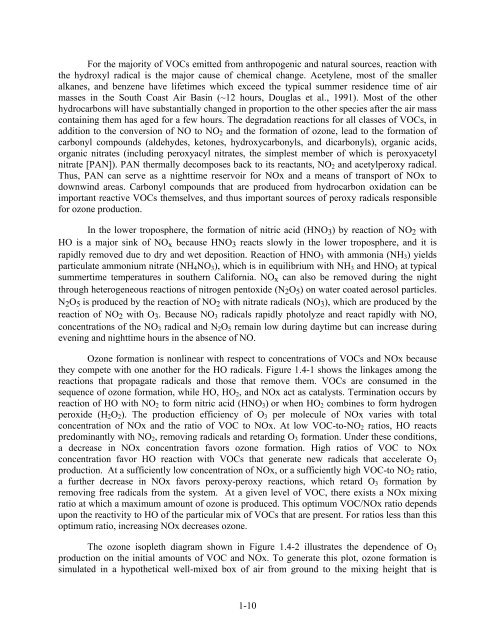Weekend/Weekday Ozone Observations in the South Coast Air Basin
Weekend/Weekday Ozone Observations in the South Coast Air Basin
Weekend/Weekday Ozone Observations in the South Coast Air Basin
Create successful ePaper yourself
Turn your PDF publications into a flip-book with our unique Google optimized e-Paper software.
For <strong>the</strong> majority of VOCs emitted from anthropogenic and natural sources, reaction with<br />
<strong>the</strong> hydroxyl radical is <strong>the</strong> major cause of chemical change. Acetylene, most of <strong>the</strong> smaller<br />
alkanes, and benzene have lifetimes which exceed <strong>the</strong> typical summer residence time of air<br />
masses <strong>in</strong> <strong>the</strong> <strong>South</strong> <strong>Coast</strong> <strong>Air</strong> Bas<strong>in</strong> (~12 hours, Douglas et al., 1991). Most of <strong>the</strong> o<strong>the</strong>r<br />
hydrocarbons will have substantially changed <strong>in</strong> proportion to <strong>the</strong> o<strong>the</strong>r species after <strong>the</strong> air mass<br />
conta<strong>in</strong><strong>in</strong>g <strong>the</strong>m has aged for a few hours. The degradation reactions for all classes of VOCs, <strong>in</strong><br />
addition to <strong>the</strong> conversion of NO to NO 2 and <strong>the</strong> formation of ozone, lead to <strong>the</strong> formation of<br />
carbonyl compounds (aldehydes, ketones, hydroxycarbonyls, and dicarbonyls), organic acids,<br />
organic nitrates (<strong>in</strong>clud<strong>in</strong>g peroxyacyl nitrates, <strong>the</strong> simplest member of which is peroxyacetyl<br />
nitrate [PAN]). PAN <strong>the</strong>rmally decomposes back to its reactants, NO 2 and acetylperoxy radical.<br />
Thus, PAN can serve as a nighttime reservoir for NOx and a means of transport of NOx to<br />
downw<strong>in</strong>d areas. Carbonyl compounds that are produced from hydrocarbon oxidation can be<br />
important reactive VOCs <strong>the</strong>mselves, and thus important sources of peroxy radicals responsible<br />
for ozone production.<br />
In <strong>the</strong> lower troposphere, <strong>the</strong> formation of nitric acid (HNO 3 ) by reaction of NO 2 with<br />
HO is a major s<strong>in</strong>k of NO x because HNO 3 reacts slowly <strong>in</strong> <strong>the</strong> lower troposphere, and it is<br />
rapidly removed due to dry and wet deposition. Reaction of HNO 3 with ammonia (NH 3 ) yields<br />
particulate ammonium nitrate (NH 4 NO 3 ), which is <strong>in</strong> equilibrium with NH 3 and HNO 3 at typical<br />
summertime temperatures <strong>in</strong> sou<strong>the</strong>rn California. NO x can also be removed dur<strong>in</strong>g <strong>the</strong> night<br />
through heterogeneous reactions of nitrogen pentoxide (N 2 O 5 ) on water coated aerosol particles.<br />
N 2 O 5 is produced by <strong>the</strong> reaction of NO 2 with nitrate radicals (NO 3 ), which are produced by <strong>the</strong><br />
reaction of NO 2 with O 3 . Because NO 3 radicals rapidly photolyze and react rapidly with NO,<br />
concentrations of <strong>the</strong> NO 3 radical and N 2 O 5 rema<strong>in</strong> low dur<strong>in</strong>g daytime but can <strong>in</strong>crease dur<strong>in</strong>g<br />
even<strong>in</strong>g and nighttime hours <strong>in</strong> <strong>the</strong> absence of NO.<br />
<strong>Ozone</strong> formation is nonl<strong>in</strong>ear with respect to concentrations of VOCs and NOx because<br />
<strong>the</strong>y compete with one ano<strong>the</strong>r for <strong>the</strong> HO radicals. Figure 1.4-1 shows <strong>the</strong> l<strong>in</strong>kages among <strong>the</strong><br />
reactions that propagate radicals and those that remove <strong>the</strong>m. VOCs are consumed <strong>in</strong> <strong>the</strong><br />
sequence of ozone formation, while HO, HO 2 , and NOx act as catalysts. Term<strong>in</strong>ation occurs by<br />
reaction of HO with NO 2 to form nitric acid (HNO 3 ) or when HO 2 comb<strong>in</strong>es to form hydrogen<br />
peroxide (H 2 O 2 ). The production efficiency of O 3 per molecule of NOx varies with total<br />
concentration of NOx and <strong>the</strong> ratio of VOC to NOx. At low VOC-to-NO 2 ratios, HO reacts<br />
predom<strong>in</strong>antly with NO 2 , remov<strong>in</strong>g radicals and retard<strong>in</strong>g O 3 formation. Under <strong>the</strong>se conditions,<br />
a decrease <strong>in</strong> NOx concentration favors ozone formation. High ratios of VOC to NOx<br />
concentration favor HO reaction with VOCs that generate new radicals that accelerate O 3<br />
production. At a sufficiently low concentration of NOx, or a sufficiently high VOC-to NO 2 ratio,<br />
a fur<strong>the</strong>r decrease <strong>in</strong> NOx favors peroxy-peroxy reactions, which retard O 3 formation by<br />
remov<strong>in</strong>g free radicals from <strong>the</strong> system. At a given level of VOC, <strong>the</strong>re exists a NOx mix<strong>in</strong>g<br />
ratio at which a maximum amount of ozone is produced. This optimum VOC/NOx ratio depends<br />
upon <strong>the</strong> reactivity to HO of <strong>the</strong> particular mix of VOCs that are present. For ratios less than this<br />
optimum ratio, <strong>in</strong>creas<strong>in</strong>g NOx decreases ozone.<br />
The ozone isopleth diagram shown <strong>in</strong> Figure 1.4-2 illustrates <strong>the</strong> dependence of O 3<br />
production on <strong>the</strong> <strong>in</strong>itial amounts of VOC and NOx. To generate this plot, ozone formation is<br />
simulated <strong>in</strong> a hypo<strong>the</strong>tical well-mixed box of air from ground to <strong>the</strong> mix<strong>in</strong>g height that is<br />
1-10
















